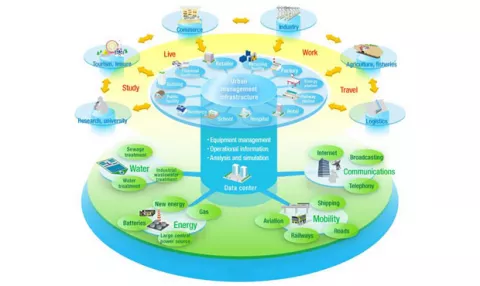
Do you know that if one lays down the cities of India in the descending order of their population, the 200th city has only 2,00,000 population. So changing the face of cities through the Smart Cities mission and AMRUT essentially means changing the face of cities with a smaller population. Colonypara in the Sunderbans through sheer determination, hard work, and local leadership of women, spread across 15 villages, joined hands to build more than 10 kilometres of brick roads, connecting several previously inaccessible villages. This has changed their lives as these villages were subject to the fury of nature in the form floods and disastrous cyclones that are frequent in this vast tract of forest and saltwater swamp. In small cities of population ranging from 1,00,000 to 3,00,000, small infrastructure development can turn out to be a big game changer.
Providing basic services (water supply, sewerage, urban transport) to households and building amenities in cities to improve quality of life for all, especially the poor and disadvantaged, is a national priority. Earlier learnings have shown that infrastructure creation should have a direct impact on the real needs of people, such as providing taps and toilet connections to all households. This means the focus should be on infrastructure creation with a direct link to provision of better services to people.
Therefore, the purpose of the Atal Mission for Rejuvenation and Urban Transformation (AMRUT) is to:
- Ensure every household has access to a tap with assured supply of water and a sewerage connection
- Increase the amenity value of cities by developing greenery and well-maintained open spaces (e.g. parks)
- Reduce pollution by switching to public transport or constructing facilities for non-motorised transport (e.g. walking and cycling).
All these outcomes are valued by citizens, particularly women, and indicators and standards have been prescribed by the Ministry of Urban Development (MoUD) in the form of service level benchmarks (SLBs). AMRUT has the potential to improve quality of life across segments; thus, it can play a significant role in changing a city's image.
Implementation of this Mission will be linked to promotion of urban reforms, such as e-governance, constitution of professional municipal cadre, devolving funds and functions to urban local bodies, review of building bylaws, improvement in assessment and collection of municipal taxes, credit rating of urban local bodies, energy and water audit, and citizen-centric urban planning. All this would improve quality of urban governance, leading to better citizen satisfaction.
This Mission will be implemented in 500 cities and towns, each with a population of 1 lakh and above; some cities situated on stems of main rivers, a few capital cities and important cities located in hilly areas, islands and tourist areas. Under this mission, 10 per cent of the budget allocation will be given to states and union territories as incentive based on the achievement of reforms during the previous year. Indeed, AMRUT has the potential to revive cities languishing for lack of basic infrastructure.
###
-The writer is Founder Director, Smart Cities Council India
Related articles:
Digital India can be a huge fillip for healthcare and education
Why cycling should be mandatory in smart cities
How aggregators like Uber & Ola are smartening the city & life at the bottom of the pyramid



